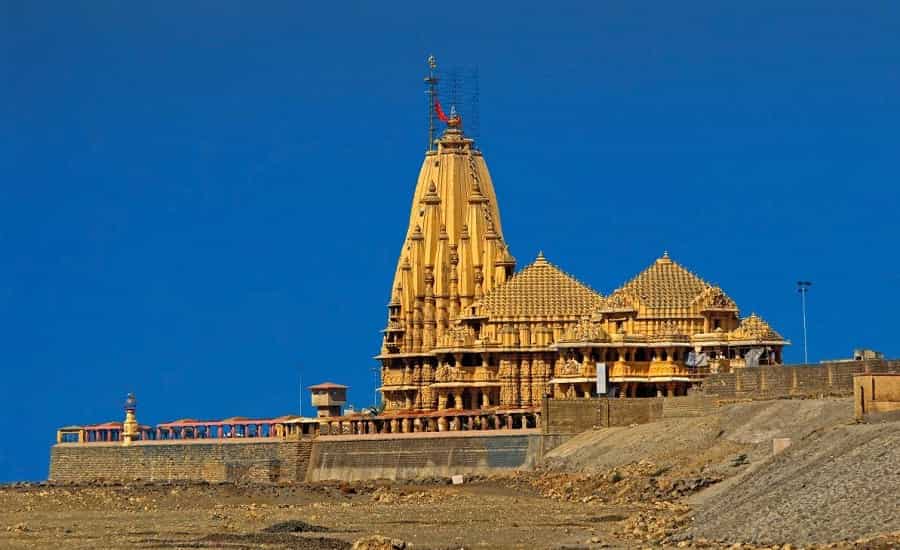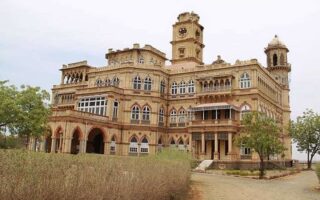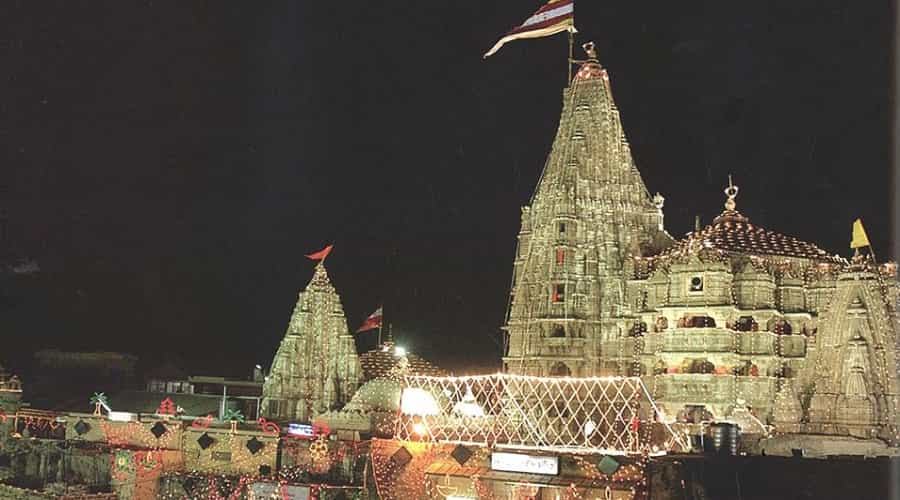In the lines of 12 Jyotirlinga Temples, this temple stands 1st. According to legend, 27 daughters were married to Daksha Prajapati by Chandra (Moon God). Of the 27 wives, Chandra spent much of her time with Rohini. The other wives protested to their father about the approach Chandra had taken. Daksha called for fair justice from Chandra. Chandra refused the proposal submitted by his father-in-law, and the same proceeded. The furious Daksha cursed Chandra for suffering from Kshaya. Chandra did penance for Lord Shiva, who partly set him free from the curse. Therefore, the explanation for the full moon and the days with no moon.
Shiva Linga was installed by Lord Chandra and he founded the Golden Temple. Hence Somanatheshwara‘s name.

As per the records, Ghazni invaded this temple in 1025 AD and plundered the wealth of 18 crores. The temple was destroyed by Alauddin Khilji and Sardar Altaf Khan in the year 1297 AD. Mahmud Begada, 1503 AD, Muzaffar shah II and 1701 AD, Aurangzeb destroyed the strong wealth in the year 1479 AD and looted it. The temple was restored by an ardent devotee, Ahilyabai Holkar, in 1583 AD.
Somnath Temple, Gujarat- Temple Facts
- During Shivratri days, the temple would be heavily crowded.
- During Maha Shivratri, the annual festival lasts for 12 days.
- On the banks of the Arabian Sea, a temple was built.
- The architecture of the temple follows the Chalukyas style of building.
- This temple has been attacked by Muslim attackers 17 times.
| Deity | Lord Somnath – Lord Shiva |
| Location | Somnath, Gujarat |
| Significance | Jyotirlinga |
| Best time to visit | December to June |
| Darshan Timing | Monday to Sunday 6:00 AM to 10:00 PM |
| Entry Fees | Free |
| Dress Code | Traditional |
| Festivals | Shravan, Shivratri, Kartik Purnima |
| Poojas | Rudrabhishek, Laghu Rudra Abhishek |
| Best Time to Visit | March and October |
Timings of Somnath Temple
At 6:00 AM, the temple opens and shuts at 10:00 PM. During this time, the temple conducts different rituals as well. These rituals, such as morning, midday, and evening aarti, can involve the devotees.
The Timings are as follows:
- Darshan- 6:00 AM to 10:00 PM
- Morning Aarti- 7:00 AM
- Afternoon Aarti- 12:00 PM
- Evening Aarti- 7:00 PM
- Live Darshan Timings- 7:00 am – 8:00 pm
Poojas Performed at Somnath Temple
Many Poojas take place at the Temple of Somnath. At Somnath Temple, the following Poojas take place:
- Homatmak Atirudra: A highly revered Yajna involving eleven recitations of Maha Rudra. It is believed to wash away sins and bring peace and prosperity.
- Homatmak Maharudra: Conducted by 56 Vedic Pandits, this pooja includes the recitation of Rudras and the four Vedas (Rigveda, Samveda, Yajurveda, and Atharva Veda).
- Homatmak Laghurudra: An Abhishek (ritual bathing) aimed at resolving health and wealth issues and mitigating the adverse effects of planetary positions.
- Savalaksha Samput Mahamrityunjaya Jaap: Focuses on enhancing longevity and immortality through chanting the Mahamrityunjaya mantra.
- Other Poojas and Abhishekams:
- Savalaksha Bilva Pooja
- Kaal Sarp Yog Nivaran Vidhi
- Shiv Puran Path
- Mahadugdh Abhishek
- Gangajal Abhishek
- Navagraha Jaap
Somnath Temple History

The Temple is assisted by a complex and elaborate background. It is said that well before the advent of the Christian period, the first iteration of the temple came into existence. About 408AD-768AD, under the initiative of the Vallabhi king, the second version of the temple came into being. This temple is also referred to as the ‘everlasting shrine’ though ancient accounts state that invaders have demolished this temple many times and have also been restored many times.
Archaeological findings suggest that the temple of Somnath was reconstructed almost three times before Mahmud Ghazni ‘s attack in 1026. It is also said that the temple was later targeted three more times. Thus, before the new 7th edition appeared, the temple was attacked and demolished as many as 6 times.
Under the initiative of Sardar Vallabhbhai Patel, the then deputy PM, the most recent restoration of the Somnath temple was carried out in 1947. As the architect, Prabhashankar Sompura was selected and the present-day Somnath temple thus came into being. The temple was inaugurated on 11 May 1950 by the then President of the country, Rajendra Prasad.
Some of the ancient texts state that during Satya Yuga, the temple was first constructed in gold by King Somraj. Ravana built it out of silver in Treta Yuga, while Lord Krishna built it out of wood in Dwapara Yuga. The temple was later designed by King Bhimdev out of brick. That is the argument made by some of our country’s ancient scriptures.
Somnath Temple Myths and Legends
There are many interesting stories connected with Somnath temple and this excites the imagination of both god lovers and inquisitive visitors. A mythological story says that here, Chandra or Moon God had committed stringent penance to free himself from a curse issued by his father-in-law, Daksha Prajapati.
It is said that the Moon God was married to the 27 daughters of Daksha Prajapati. Of his 27 wives, however, he preferred only Rohini, while neglecting the others. The neglect of his other daughters exasperated Daksha Prajapati, so the moon cursed him that he would soon lose all of his lusters. Then the worrying moon went down to Prabhas Patan to pray to Lord Shiva and rid himself of the curse. Ultimately, Lord Shiva was delighted with his devotion and released him from the curse. God set up a Jyotirlingam at this site, which later became known as the Somnath temple, out of gratitude to Moon.
Somnath Temple Architectural Excellence
The temple has an elaborate and extravagant architecture that is characterized by many rich, intricate carvings. The temple has seven floors and achieves an altitude of up to 155 feet. The architectural style displayed by the temple is the architectural Chalukya style. Ideally, the architectural elegance of the Somnath Temple mirrors the masonry skills of the Sampuras, master masons of Gujarat.
The Shikhara temple is crowned by a splendid Kalash or pot vessel and roughly weighs up to 10 tones. A flag whose mast is 37 ft in length adorns the summit. The entrance to the temple has an attractive picture gallery above it. This gallery displays images telling the story of the remains, repairs, and excavations of the ancient temple. The architecture of the temple is beautiful and is decorated with breath-taking stone carvings & sculptures.
How to Reach Somnath Temple
By Road:
- From Ahmedabad: 400 km; accessible by bus or taxi.
- From Junagadh: 85 km; bus and taxi available.
- From Bhavnagar: 266 km; bus and taxi options.
- From Porbandar: 122 km; bus or cab.
- From Mumbai: 889 km; bus or taxi, or drive.
By Train:
- Nearest Station: Veraval, 7 km away.
- Train Service: Somnath Express from Ahmedabad. From Veraval, take a bus, taxi, or auto-rickshaw.
By Air:
- Nearest Airport: Keshod, 55 km away.
- Flights: Regular flights from Mumbai. From Keshod, use local transport to reach Somnath.
Some Famous Temples near Somnath
There are several temples to visit near the beautiful city of Somnath.
- Bhalka Tirth: The Prabhas- Veraval highway is 5 km away. Sri Krishna, who was resting under the Peepal tree, was hit by an arrow shot by poacher Jara at this spot. Then, Lord Sri Krishna walked and reached the banks of the Hiran River, from where he began his last journey.
- Shri Golok Dham Teerth or Shri Krishna Neejdham Prasthan Place: It is on the banks of the Hiran River, 1.5 km away from the Temple of Somnath. Here, the footprint of Lord Krishna is carved to mark the temple’s location. Balaram, Lord Krishna’s elder brother, also began his last journey from here in his original serpent shape.
- Junagadh Gate: This is one of Gujarat’s most popular tourist attractions. Mohammad of Ghazni entered through this gate a long time ago and plundered the famed Somnath temple and transformed it into ruins. This memorial, although it has worn out over time, continues to draw lovers of history.
Some other Famous Temples in Gujarat are:
- Dwarkadhish Temple: It is one of the pilgrimages to Char Dham, located in the Gujarat town of Dwarka. On the banks of the river Gomti, in Saurashtra, lies Dwarka. It is traditionally known as Lord Krishna’s capital. Except for the Temples, the city gradually drowned itself beneath the water.
Also Reda:
Best Places to visit in Dwarka, Gujarat
Best Places To Visit In Gujarat


